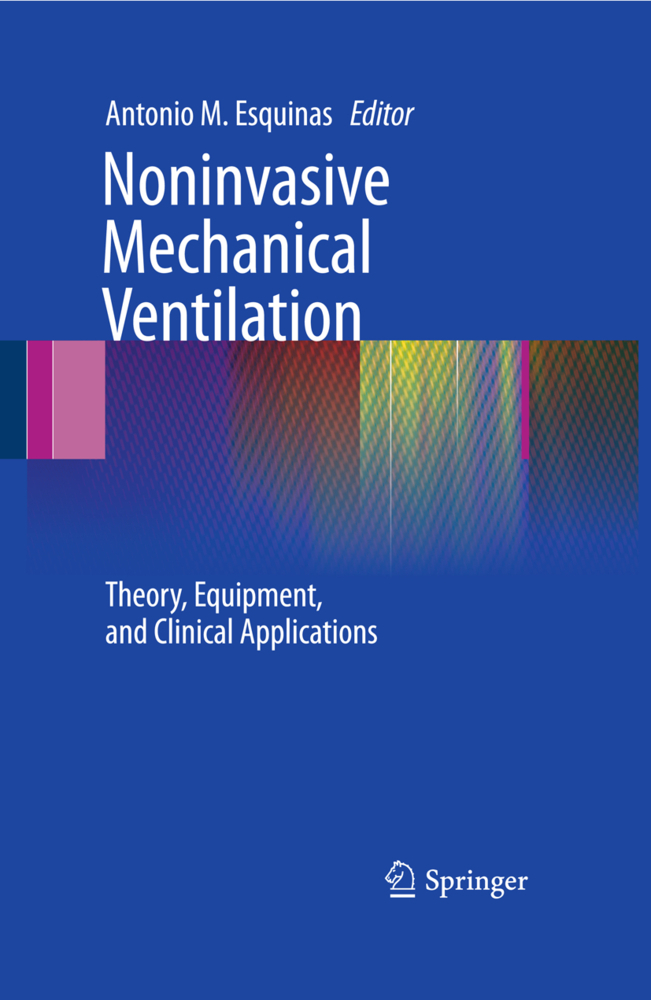Noninvasive Mechanical Ventilation
Noninvasive mechanical ventilation is an effective technique for the management of patients with acute or chronic respiratory failure. This comprehensive and up-to-date book explores all aspects of the subject. The opening sections are devoted to theory and equipment, with detailed attention to the use of full-face masks or helmets, the range of available ventilators, and patient-ventilator interactions. Clinical applications are then considered in depth in a series of chapters that address the use of noninvasive mechanical ventilation in chronic settings and in critical care, both within and outside of intensive care units. Due attention is also paid to weaning from conventional mechanical ventilation, potential complications, intraoperative applications, and staff training. The closing chapters examine uses of noninvasive mechanical ventilation in neonatal and pediatric care. This book, written by internationally recognized experts, will be an invaluable guide for both clinicians and researchers.
1;Contents;5 2;Abbreviations;11 3;Section I Interface Technology in Critical Care Settings;15 3.1;1: Full Mask Ventilation;16 3.1.1;1.1 Introduction;16 3.1.2;1.2 Total-Face Mask During NPPV;17 3.1.3;1.3 Discussion;18 3.1.4;Key Recommendations;18 3.1.5;References;19 3.2;2: Helmet Continuous Positive Airway Pressure: Theory and Technology;20 3.2.1;2.1 Introduction;20 3.2.2;2.2 Helmet Technology;20 3.2.2.1;2.2.1 Helmet to Deliver Noninvasive CPAP;21 3.2.3;2.3 Limitations of the Technique;22 3.2.3.1;2.3.1 Carbon Dioxide Rebreathing;22 3.2.3.2;2.3.2 Noise;23 3.2.3.3;2.3.3 Pressure Monitoring and Generators;24 3.2.4;Key Recommendations;24 3.2.5;References;25 3.3;3: Helmet Continuous Positive Airway Pressure: Clinical Applications;26 3.3.1;3.1 Introduction;26 3.3.1.1;3.1.1 Acute Cardiogenic Pulmonary Edema;27 3.3.1.2;3.1.2 Acute Noncardiogenic Respiratory Failure;27 3.3.2;3.2 Experience with Helmet CPAP at Our Institution;29 3.3.3;3.3 Conclusion;30 3.3.4;Key Recommendations;30 3.3.5;References;31 4;Section II Ventilatory Modes and Ventilators: Theory, Technology, and Equipment;32 4.1;4: Pressure Support Ventilation;33 4.1.1;4.1 Introduction;33 4.1.2;4.2 Mechanisms of Action;34 4.1.3;4.3 Patient-Ventilator Interaction;35 4.1.4;4.4 Conclusions;37 4.1.5;Key Recommendations;38 4.1.6;References;38 4.2;5: Ventilators for Noninvasive Mechanical Ventilation;39 4.2.1;5.1 Introduction;39 4.2.2;5.2 Classification of Ventilators;40 4.2.3;5.3 Technologic Issues;42 4.2.3.1;5.3.1 Source of Gas and Oxygen Supply;42 4.2.3.2;5.3.2Circuit;42 4.2.3.3;5.3.3 Inspiratory Trigger and Expiratory Cycle;44 4.2.3.4;5.3.4 Inspiratory Flow;45 4.2.3.5;5.3.5 Backup Respiratory Rate;45 4.2.3.6;5.3.6 Air Leak Compensation;46 4.2.3.7;5.3.7 Battery;47 4.2.3.8;5.3.8 Alarm and Monitoring System;47 4.2.4;5.4 Controversial Issues;48 4.2.5;Key Recommendations;49 4.2.6;References;49 4.3;6: Noninvasive Positive Pressure Ventilation Using Continuous Positive Airway Pressure;51 4.3.1;6.1 Introduction;51 4.3.2;6.2 Equipments;51 4.3.2.1;6.2.1 Continuous Positive Pressure Flow Generators;51 4.3.2.2;6.2.2 Intensive Care Unit Ventilators (High-Pressure-Driven Ventilators);52 4.3.2.3;6.2.3 Ventilators Designed to Administer Noninvasive Positive Pressure Ventilation;52 4.3.2.4;6.2.4 Boussignac CPAP;53 4.3.2.5;6.2.5 Bubble CPAP;53 4.3.3;6.3 Discussion;54 4.3.4;Key Recommendations;54 4.3.5;References;54 4.4;7: Home Mechanical Ventilators;56 4.4.1;7.1 Introduction;56 4.4.2;7.2 Technology and Equipment;56 4.4.2.1;7.2.1 Ventilators;56 4.4.2.2;7.2.2 Mechanical Ventilation Modes;57 4.4.2.2.1;7.2.2.1 Initiation of Positive Pressure;57 4.4.2.2.2;7.2.2.2 Gas Delivery by the Ventilator During Inspiration;58 4.4.2.2.3;7.2.2.3 Cycling Off Variable;59 4.4.2.3;7.2.3 Interfaces for the Delivery of Noninvasive Ventilation;59 4.4.2.3.1;7.2.3.1 Nasal Interfaces;59 4.4.2.3.2;7.2.3.2 Oronasal Interfaces;59 4.4.2.3.3;7.2.3.3 Mouth Interfaces;59 4.4.2.4;7.2.4 Humidification;60 4.4.2.5;7.2.5 Safety;60 4.4.3;7.3 Conclusion;60 4.4.4;References;60 4.5;8: Maintenance Protocol for Home Ventilation Circuits;62 4.5.1;8.1 Introduction;62 4.5.2;8.2 Equipment for Home Mechanical Ventilation;62 4.5.2.1;8.2.1 Dirtiness, Contamination, Colonization;63 4.5.2.2;8.2.2 Maintenance Is Empirically Driven;63 4.5.2.3;8.2.3 A European Survey on Maintenance;63 4.5.2.4;8.2.4 Patients Do Not Clean Their Equipment;64 4.5.2.5;8.2.5 Sensitivity to Infections;64 4.5.3;8.3 Analysis and Discussion;64 4.5.3.1;8.3.1 Restrictive Disorders;64 4.5.3.2;8.3.2 Obstructive Disorders;65 4.5.4;Key Recommendations;68 4.5.5;References;68 4.6;9: Nocturnal Noninvasive Mechanical Ventilation;69 4.6.1;9.1 Introduction;69 4.6.2;9.2 Effect of Nocturnal Mechanical Ventilation;70 4.6.3;9.3 Equipment Requirements for Nocturnal Ventilation;71 4.6.3.1;9.3.1 Type of Ventilator;71 4.6.3.2;9.3.2 Modes of Ventilation;72 4.6.3.3;9.3.3 Type of Interface;72 4.6.4;9.4 Conclusion;73 4.6.5;Key Recommendations;73 4.6.6;References;73 5;Section III Patient-Ventilator Inte
Esquinas, Antonio M.
| ISBN | 9783642113659 |
|---|---|
| Artikelnummer | 9783642113659 |
| Medientyp | E-Book - PDF |
| Auflage | 2. Aufl. |
| Copyrightjahr | 2010 |
| Verlag | Springer-Verlag |
| Umfang | 402 Seiten |
| Kopierschutz | Digitales Wasserzeichen |

